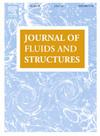Synthesis and characterisation of turbulent flows to predict fatigue loading of tidal turbines in arrays
IF 3.4
2区 工程技术
Q1 ENGINEERING, MECHANICAL
引用次数: 0
Abstract
The onset flows used for tidal turbine design are, at present, based on simplifications of the naturally occurring tidal flow, and design standards consider in-wake loading based on an effective turbulence parameter. This work uses a quasi-steady blade element momentum model to assess alternative unsteady onset flow characterisation methods for prediction of the fatigue loading of turbines, when operating in the complex onset flows that occur in an array. Fatigue loads are evaluated for each turbine within a two-row array using onset turbulent flow from both a large eddy simulation and synthesised by superposition of shear, an empirical wake model and a spectral turbulence model. This is shown to provide blade damage equivalent loads within 1% for a turbine operating in the highest transverse shear region when compared to the direct use of the Large Eddy Simulation (LES) flow fields. Fatigue loads vary with turbulence and onset shear. Approaches for characterising such flows and resultant loads are evaluated including based on effective turbulence and on the signal to noise ratio (SNR) of the relative velocity to the blade at a radial position close to the centroid of the load. In isolation each approach provides loading to within 20% of the predicted trend for only up to 50% of cases. However, a combined approach considering the SNR when greater than 0.2 enables the SNR method to calculate to within 20% of the predicted trend for 97% of cases. For the cases where the SNR value is less than 0.2, the predicted trend from the relationship between effective turbulence and normalised damage equivalent load, can predict the loads to within 20% for 88% of the cases.
预测阵列潮汐涡轮机疲劳载荷的湍流综合与表征
目前用于潮汐水轮机设计的起流是基于对自然潮汐流的简化,设计标准考虑基于有效湍流参数的尾流载荷。这项工作使用准稳定叶片单元动量模型来评估用于预测涡轮机疲劳载荷的非定常开始流动的替代表征方法,当在阵列中发生复杂开始流动时。利用大涡模拟和剪切叠加、经验尾迹模型和频谱湍流模型合成的起始湍流,对两排阵列内的每个涡轮进行疲劳载荷评估。结果表明,与直接使用大涡模拟(LES)流场相比,在最高横向剪切区域运行的涡轮,叶片损伤等效载荷在1%以内。疲劳载荷随湍流和起始剪切而变化。描述这种流动和由此产生的负荷的方法进行了评估,包括基于有效湍流和相对速度的信噪比(SNR)叶片在径向位置接近负荷的质心。孤立地说,每种方法最多只能为50%的病例提供在预测趋势20%以内的负荷。然而,考虑信噪比大于0.2时的组合方法使信噪比方法在97%的情况下计算到预测趋势的20%以内。对于信噪比小于0.2的情况,根据有效湍流度与归一化损伤等效载荷之间的关系预测的趋势,88%的情况下可以预测20%以内的载荷。
本文章由计算机程序翻译,如有差异,请以英文原文为准。
求助全文
约1分钟内获得全文
求助全文
来源期刊

Journal of Fluids and Structures
工程技术-工程:机械
CiteScore
6.90
自引率
8.30%
发文量
173
审稿时长
65 days
期刊介绍:
The Journal of Fluids and Structures serves as a focal point and a forum for the exchange of ideas, for the many kinds of specialists and practitioners concerned with fluid–structure interactions and the dynamics of systems related thereto, in any field. One of its aims is to foster the cross–fertilization of ideas, methods and techniques in the various disciplines involved.
The journal publishes papers that present original and significant contributions on all aspects of the mechanical interactions between fluids and solids, regardless of scale.
 求助内容:
求助内容: 应助结果提醒方式:
应助结果提醒方式:


